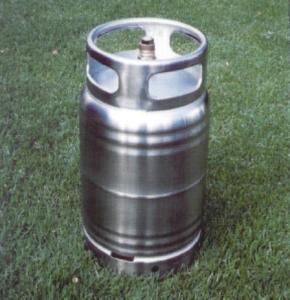- Making Stainless Even Better
- Sassda News
- New Alloy to Combat Cost of Nickel
- A Brighter Future For Stainless
- Markedly Different Trading Environment
- Czech-Mate
- Building the Use of Stainless
- New Stainless Project
- Latest on SSCDI Activities
- The Currency of the Future
- New Autocat Factory
- Partnering Alliances Froth Up Market
- Stainless for Millennium Bridge
- South Africa’s Stainless Sector Shines Bright
- Sector Fails to Steel Itself for E-Commerce
- Stainless in Space
- Using Stainless for LPG Cylinders is a Gas

Stainless can comply with all the physical requirements demanded of carbon steel for the containment of gases.
An investigation has revealed that, despite the recent releases of the fifth edition of SABS 019, “Transportable metal containers for compressed gas – basic design, manufacture, use and maintenance”, mild steel boiler plate is still specified as the permitted material of manufacture. This precludes the use of austenitic stainless, an anachronism that needs to be addressed urgently.
In this day and age of increasingly sophisticated and advanced stainless steels, one can only see this is an anachronism that must be addressed by the powers that control SABS specifications. This becomes even more pertinent if liquid petroleum gas (LPG) is to be promoted as an alternative energy source to paraffin and electricity in the far-flung rural areas of southern Africa.
Apart from this one specification stumbling block, stainless can comply with all the physical requirements demanded of carbon steel for the containment of gases. More importantly, it can add a few benefits like a 50% weight-saving bonus, easier drawing and machining, and dramatically-reduced finishing to make it highly cost-competitive.
It must be pointed out that stainless gas cylinders of all common sizes are currently being manufactured in Spain to the tune of a million units a year. Admittedly these are designed for butane gas only, and not the propane/butane mixtures required for our local ambient temperature conditions. We understand from a reliable source, however, that this is a mere technicality, because a slight increase in wall thickness will allow for this easily.
Specifications can be rewritten
As we see it, the SABS 019 specification, which was first issued in 1951, can easily be rewritten to incorporate acceptable standards for stainless as well as carbon steel. The question is, who must take the initiative? With the possibilities of job creation, perhaps it should be the trade unions?
It is unlikely that the large players in the existing bottled gas market will take action, for the simple reason that they have massive investments in carbon steel cylinders. But with the completion of the Pande/Temane Mozambique pipeline to Secunda, major changes in gas marketing are imminent, and natural gas will be readily available as a (hopefully) cheap energy source for industry.
This will free butane propane capacity to feed rural areas. Given the availability of low-cost stainless steel cylinders, this could spark a great demand for bottled gas for cooking, lighting, and portable generator sets in the foreseeable future. What better material than stainless to resist the hard knocks of transport and handling along the rural supply chain?
Cost-competitive with mild steel
Our informant in the stainless industry assures us that stainless gas cylinders will be cost-competitive with mild steel, and much better able to resist corrosion and damage. With hundreds of millions of rands invested in their existing cylinders, the vested interest brigade will not budge on changing SABS 019. As business enterprises with investors to satisfy, no one can blame them.
But South Africa cannot overlook opportunities and bury its head in the sand. One suggestion is to join forces with the Departments of Minerals and Energy and Labour to create a completely new specification relating only to stainless LPG cylinders.
Perhaps this is also a challenge for one of the trade unions to invest in, or at least encourage, a new industry that will provide direct, or indirect employment for possibly hundreds of thousands of South Africans, and give a much needed boost to member contributions. We are already witnessing the establishment of a gas reticulation company backed by Cinergy Global.
A major economic boost
This points to the fact that natural gas is going to give the South African economy a major boost within the next two to three years. This will free up some 100 000 t of propane/butane gas production for small users such as restaurants, country hotels and domestic users. LPG can be delivered at prices (excluding the cost of cylinders) competitive to paraffin and electricity.
The manufacture of stainless LPG cylinders, not to mention cylinders for industrial and medical gases, together with all the various appliances and attachments that go with them, could stimulate major local and export market developments. A whole new industry can be developed by smaller entrepreneurs in competition to the vested interest that are not going to raise a finger to help.


